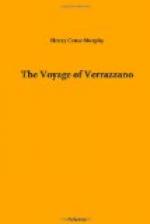Although a voyage from France to the Indies for spices was not an improbable venture at that time inasmuch as one was actually made from Dieppe, two years afterwards, by Jean Parmentier in the service of Ango, there is every reason to believe that such was not the real object of the parties to this agreement. One of the stipulations between them was for a division, of booty, showing an intention to make captures on the sea. Who were the enemies of the king from whom it was to be taken is not stated. By the treaty of Madrid, in January 1526. peace existed between France and Spain, and any expedition from one of them against the commerce of the other, was clearly piratical. Neither did war exist at this time, between France and Portugal. Yet it appears that both the Spaniards and the Portuguese, were searching for Verrazzano at the time, when the former succeeded in capturing him, in September or October 1527. He had, therefore, not sailed to the Indies and must have made himself obnoxious to those nations, by fresh depredations upon their vessels. Bernal Diaz, who gives an account of his capture and execution, states that he was actually so engaged. [Footnote: Historia verdadera, fol 164.] It appears from the letters of the judge who superintended his execution that he was then encountered by six Biscayan galleons and ships, and after battle, captured and taken by them to Cadiz, with his crew, consisting of one hundred and twenty or thirty persons, besides several gentlemen adventurers, Verrazzano offered his captors thirty thousand ducats to be released, but in vain. He was sent under guard with the adventurers to Madrid, but was overtaken on the way at Colmenar near Puerto del Pico, villages between Salamanca and Toledo, [Footnote: Blaen, Utriusque Castilia nova descripto. Martiniere, Dictionaire Geographique, aub Colmenar et Pico.] by the judge of Cadiz with an order made by the emperor at Lerma on the 13th of October 1527, by virtue of which he was there put to death in November of that year. Such was the termination of the career of this hold man, which was long ago substantially told by Bernal Diaz and Barcia, but so loosely in regard to dates, as to have created doubts as to their correctness, but which is established by the documents existing in the archives at Simancas, now brought to light. [Footnote: See the letter of the judge of Cadiz, in the Appendix (V.L.) Barcia, in his Chronological Essay, mentions the capture and execution of Juan the Florentine as a pirate under the year 1524. He does not state that they took place in that year, but refers to them in connection with the discoveries alleged to have been made in that year by Verrazzano, whom he identifies as the corsair. It has been supposed, consequently, that he meant that year as the time of Verrazzano’s death; and hence, inasmuch as Verrazzano was known to have been alive after that year, that the whole story was an error. The letters of Juan de Giles, the resident judge of Cadiz,




